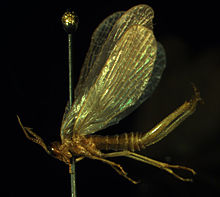- Merope tuber
-
Merope tuber 
Merope tuber Conservation status NEScientific classification 
Kingdom: Animalia Phylum: Arthropoda Class: Insecta Order: Mecoptera Family: Meropeidae Genus: Merope Binomial name Merope tuber
Newman, 1838Merope tuber the earwigfly or sometimes "forcepfly"[1] is the only species in the genus Merope, and the only living member of the family Meropeidae in North America. It occurs throughout the east from Ontario to Georgia, and west to Kansas. Recently the insect has also been found in Florida.[2] This insect's most distinguishing feature is the segmented cerci on the male abdomen. The function of these is not known, but they may be used during courtship.[citation needed] Much is unknown about the adults, which are secretive, sometimes found under logs or in malaise traps near streams. The insect is characterized by long wings with many veins and the no ocelli. There is a region of interlocking sclerites that holds the jugum and scutellum on the middle thoracic segment together. This may be used to keep the wings together when pushing up through dirt.[3] A similar apparatus is found in cicadas and ground dwelling beetles, so it may be that the winged adults dig in soil. The flat appearance of the insect suggests that the insect dwells close to the ground in fissures and other small ground openings,[4] as does the lack of ocelli.
References
- ^ R. H. Arnett. 2000. American insects: a handbook of the insects of America north of Mexico. p. 834
- ^ J. C. Dunford, P. W. Kovarik, L. A. Somma, D. Serrano (2009-07). "First state records for Merope tuber (Mecoptera: Meropeidae)in Florida and biogeographical implication". http://www.fcla.edu/FlaEnt/fe90p581.pdf. Retrieved 2010-06-23.
- ^ Hlavac, T.F. (1974). "Merope tuber (Mecoptera): A wing-body interlocking mechanism". Psyche 81: 303. doi:10.1155/1974/45917.
- ^ J.C. Dunford, D. Serrano, and L.A. Somma (2006). Earwigflies in the Great Smokies. http://www.fsca-dpi.org/SEBiolEarwigfly.pdf.
Further Reading
- Wills, Allan (2007). "Earwig Flies? Ancient and Mysterious Insects". Western Wildlife 12 (1): 5.
- Robin McLeod (2005-11-06). "Species Merope tuber - Forcepfly". http://bugguide.net/node/view/36596. Retrieved 2010-06-23.
- Snodgrass and Wigglesworth- Cornell Undergraduate Entomology Club (2009-01-25). "The Hunt For Merope Tuber...". http://www.rso.cornell.edu/bugclub/merope.html. Retrieved 2011-01-30.
This Mecoptera related article is a stub. You can help Wikipedia by expanding it.
